The Postal system
The act of sending letters from one person to another developed soon after the invention of writing, however, the creation of a formal postal system developed much later. One of the first examples of a messenger service occurred in Ancient Egypt where pharaohs used couriers to deliver written documents. Persia, India and China are all thought to be the place where the first formal postal system started around 2500 to 2200 years ago. The earliest well documented postal system, however, comes from Rome, which started 2077 years ago. The postal system was used for government communication and mail was transported by carriages pulled by horses and carts pulled by oxen.
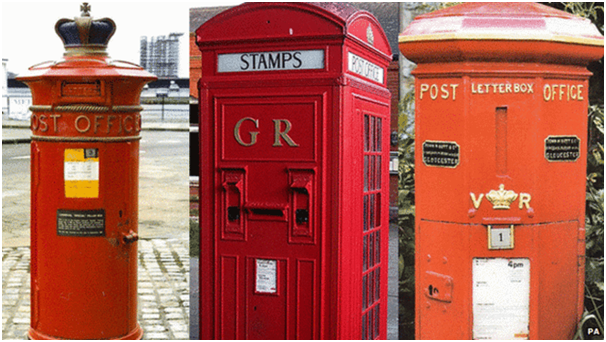 Postal System Image source
Postal System Image source
In 1505 a postal system was established in Roman Empire by Holy Roman Emperor Maximilian. This service was run by the Thurn and Taxis family, and for the first time anybody could send mail if they were able to pay the required fee. Post houses became post offices where mail or checks could be dispatched and collected. Postal services continues to develop and become accessible to the public across Europe, and by the mid 1800’s they were no longer privately run and governments had sole control over the postal system.
The South African postal system began in 1781, mail workers in Simons Town, Saldana Bay and Robben Island had to handle official mail documents. As the postal system grew, the first South African stamp, the Cape Triangular stamp was created in 1853. By 1860 post-boxes were put up in Cape Town. Previously mail was transported by trains, however, since 1911 motorcars and eventually airplanes were used to transport mail in South Africa.
The South African Post Office Limited was established in 1991. Since 1993, mail was no longer transported by trains or aeroplanes, only moto vehicles wold be used. During South Africa’s first democratic elections, the Post Office issued a set of stamps which had a peace theme. In 2002, former president Thabo Mbeki signed the Electronic Communication and Transaction Act into law by making use of The Post Office’s electronic signing device. This was a world first and made the post office the "preferred authentication service provider" of identification procedures necessary for the issuing of advanced electronic signatures.
The postal system has made it possible for people to send and receive letters or parcels from within their country or from one country to another country.
Did you know?
Envelopes were not always made from paper, letters were wrapped in animal cloth, vegetable parts and even thin sheets of baked clay.
Doctor Maurice Levy, a Canadian electronics scientist invented the first automatic postal sorter in 1957, it could sort around 200 000 letters every hour.
In 1837 the first adhesive postage stamp was invented by Roland Hill, a school mater in England. The stamp has a picture of Queen Victoria and is known as the Penny Block stamp. The development of the Penny Black stamp meant people could pay for the postage in advance, and would be charged at flat rate instead of per page delivered.
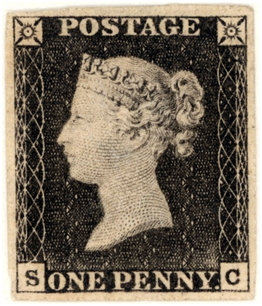 The Penny Black postage stamp. Image source
The Penny Black postage stamp. Image source
The Telegraph
The Electronic telegraph was invented in the 1830’s by Samuel Morse. This made it possible for people to send messages over long distances without having to travel, previously less reliable methods such as smoke signals were used. The way messages were sent was by using Morse code which travelled through wires or cable. These were long and short pulses of electric current which represented different letters. The first telegraph message was sent by Morse in 1844. The message read “What hath God wrought?”, and was sent over an experimental line from Washington, D.C., to Baltimore, travelling around 80 KM
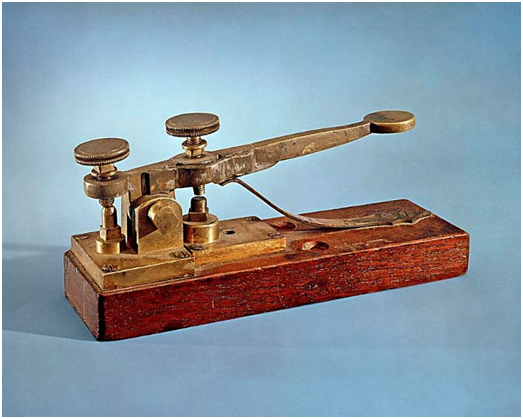 The Penny Black postage stamp A Morse Telegraph machine. Image source
The Penny Black postage stamp A Morse Telegraph machine. Image source
The first long distance wireless telegraph was invented by Guglielmo Marconi. Passengers on the RMS titanic used this to send an SOS in 1912. An SOS which is a distress signal sent when a person is in danger, especially at sea.
Below is an image of the letters of the alphabet and their code. How would you write SOS in Morse Code?
The telephone
The telephone was invented by Alexander Graham Bell in 1876. He was actually trying to create a new telegraph but when he called for his assistant after spilling something on is clothes, his assistant was able to hear his voice over the wire. Bell discovered that that sound could be sent over wires, this made two way conversations possible.
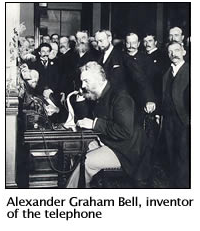
At first only the rich could afford the telephone because the materials needed for connection were quite expensive. However, once it became more widely available, the telephone had a huge impact on society. It lead to the development of city centres, office buildings and the concept of an urban worker society. At the same time, jobs such as telegraphers and messenger boys were no longer needed. The business world became more accessible; long distance deals could be made. The telephone served well in emergencies as people could immediately contact the police or an ambulance, but also introduced new types of scams and security threats. The telephone is an all-purpose tool. It is used in the home, business and in education. It is a source of entertainment and a vital resource to the illiterate as well as the academic elite.
How the telephone was invented
Radio
The invention of the radio is built on the development of the telegraph and the telephone. The radio works through changing sounds or signals into radio waves which can then travel through air space and even solid objects. Once this signal reaches the radio receiver, it changes back into the sound it initially was. When Guglielmo Marconi invented the first wireless telegraph, he made use of radio waves to transmit Morse code. The transmitter that he used to do this became known as the Radio. However, many others have claimed to be the inventor of the Radio, such as Alexander Popov, a Russian physicist and Nikola Tesla who claimed to have invented the wireless telegraph in 1893.
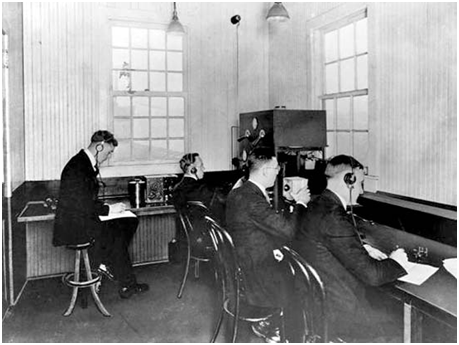 The KDKA, the first commercial radio station.
The KDKA, the first commercial radio station.
The first commercial radio station was started by the Westinghouse electrical company in the USA in the early 1920’s. Listeners were able to experience far away events such as boxing matches as they were happening. The sales of radios and the numbers of radio stations skyrocketed. Churches, Universities, Newspaper Publishers, and Municipalities all began broadcasting. By the 1930’s commercial radio stations became what they are today, playing music, having advertisement and content. As will be discussed the radio like the inventions before it was important for the further development of wireless communication technology.
History of the radio
The Typewriter
The first typewriter was invented by Christopher Latham Sholes in 1867. Other typewriter prototypes had existed prior, however, it was Sholes’s typewriter which was the first to be commercially successful. Around 20 years after its invention and modification, the typewriter began selling well to the public. One of the reasons it took two decades to sell successfully to the public was due to the fact that many people felt unsure about using a machine for typing, and wondered if it would actually be faster than writing by hand.
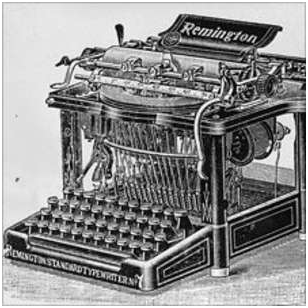 Sholes typewrite which was manufactured by Remington. Image source
Sholes typewrite which was manufactured by Remington. Image source
The typewriter helped correspondence and keeping accounts began to rely on the technology to efficiently do their jobs. Typing proved less time consuming than writing, which meant information could be communicated faster. There were a number of improvements made to business communication such as an increase in documentation and record keeping for memos, contracts, invoices and other billing needs.
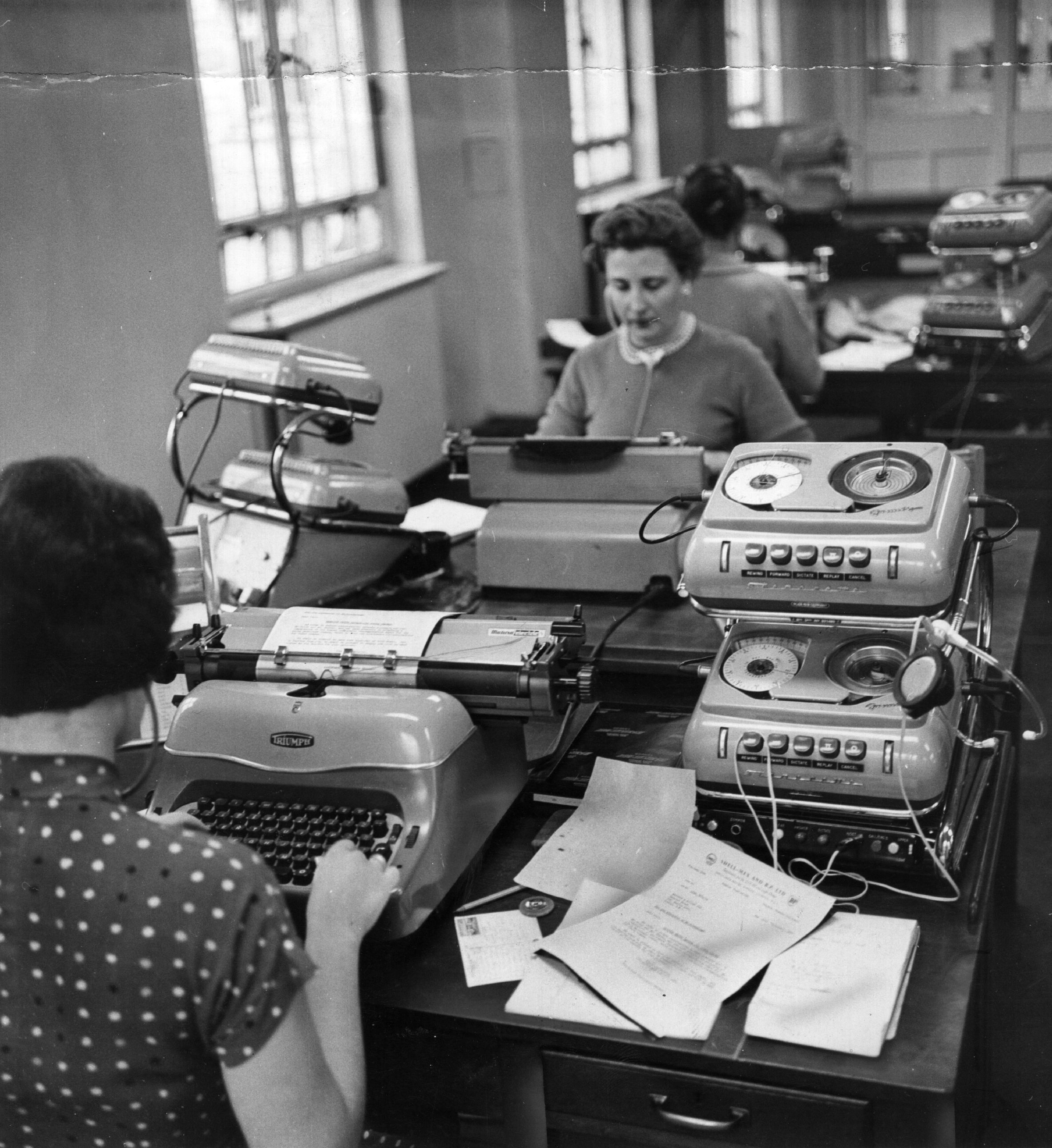 The typewriter also strongly influenced women’s work, giving them new skills and responsibilities. Image source
The typewriter also strongly influenced women’s work, giving them new skills and responsibilities. Image source
The typewriter also strongly influenced women’s work, giving them new skills and responsibilities. Secretarial positions were dominated by women from the late 1800’s, and with the introduction of the typewriter into the business world, the job of a secretary became a skilled position. This meant that women had to have specific training in typing and that they could expect better pay, and thus more educated, empowered and valued in the workplace.
The Television
As with many inventions, the invention of the television depended on previous inventions and its actual inventor is contested. People began experimenting with the television during the 1800’s. In 1926, John Loggie Baird transmitted the first moving television picture and in 1930 he made the first public broadcast of a TV show, from his studio to the London Coliseum Cinema. The technology behind the television is that firstly the TV camera changes pictures into electrical pulses, this is sent along cables, radio waves or a satellite. This travels to a television receiver, where it changes back into a picture. It became possible to send sound and pictures over airwaves. Baird went on to develop the colour television in 1928, and the stereo television in 1946.
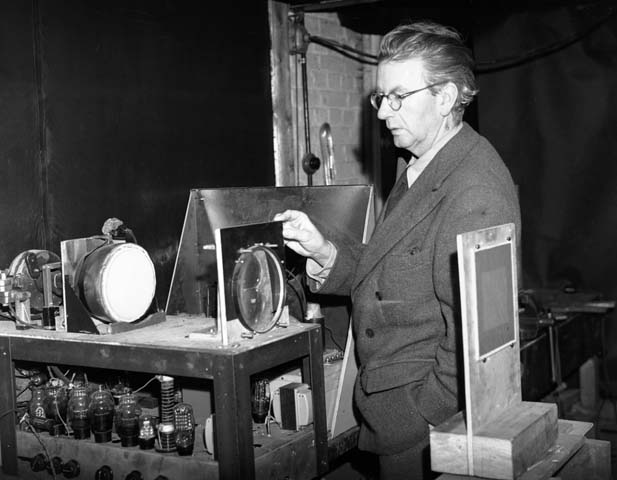 John Loggie Baird demonstrating his colour television in December 1942. Image source
John Loggie Baird demonstrating his colour television in December 1942. Image source
The TV was first introduced in the United States of America. After WWII, in the late 1940’s, mots American homes had television sets. The first televisions were black and white, only 30 years later, in 1953 did colour televisions become available. It was only after World War II that televisions sets and a wide range of programming became available in most American Household. This was different for South Africa, the television was only introduced to the country in 1976 and only had one channel. Slowly another channel was added and the first subscription based service, MNET was launched 1986. One of the longest running television shows, Carte Blanche was created in 1988, and can still be watched on TV today.
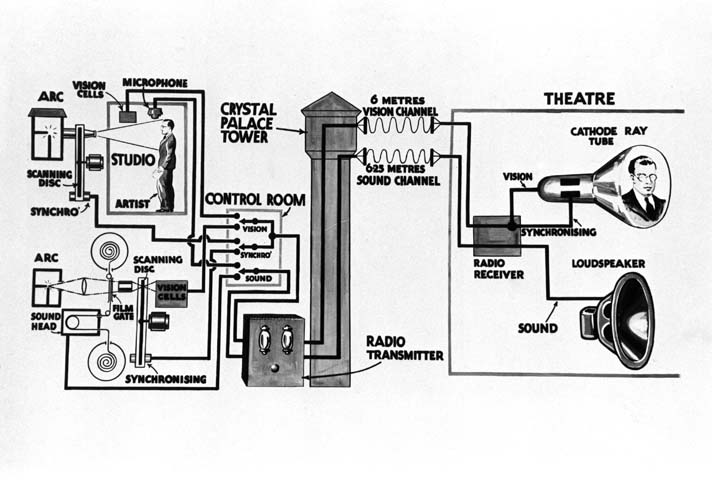 This diagram explains how Baird’s television works. Image source
This diagram explains how Baird’s television works. Image source
The history of the camera
The first camera, the Kodak, camera went on sale in 1888. This was designed by George Eastman and was a simple box camera with a single shutter speed and fixed focus lens. The development of the camera began on ancient Greece and ancient China where a ‘camera obscuro’ was created to project images of the surroundings onto a screen. This invention was important for the development of future cameras. Oskar Barnack developed a compact camera which used 35 mm film in 1913, after some improvements it entered the market in 1925.
 Kodak’s disposable camera: The Kodak Fling. Image source
Kodak’s disposable camera: The Kodak Fling. Image source
In 1948 Polaroid cameras began being sold. For the first time photographers could get the photographs after they took the photo in less than a minute. The disposable camera was invented the following year; however, they only became widely used in the 1990’s when Kodak disposable cameras became popular. These are cheap camera’s which can be used once, great for vacations. Kodak also began selling the first commercial digital camera in 1991. The development of the digital camera was dependent on the advances made in imaging technology by Willard S Boyle and George E Smith.
The cell phone
Today we use cell phones for just about everything, playing games, watching videos, listening to music, checking emails, browsing the internet and of course making phone calls. The first hand held portable cell phone was the Motorola DynaTAC which launched in 1973. Very different to the sleek and lightweight cell phones available now, the Motorola DynaTAC weighed 1.1 kilograms and was 22.9 centimetres long. Before its invention there were even bigger phones available which were considered to be “car phones” as they were too big to carry around.
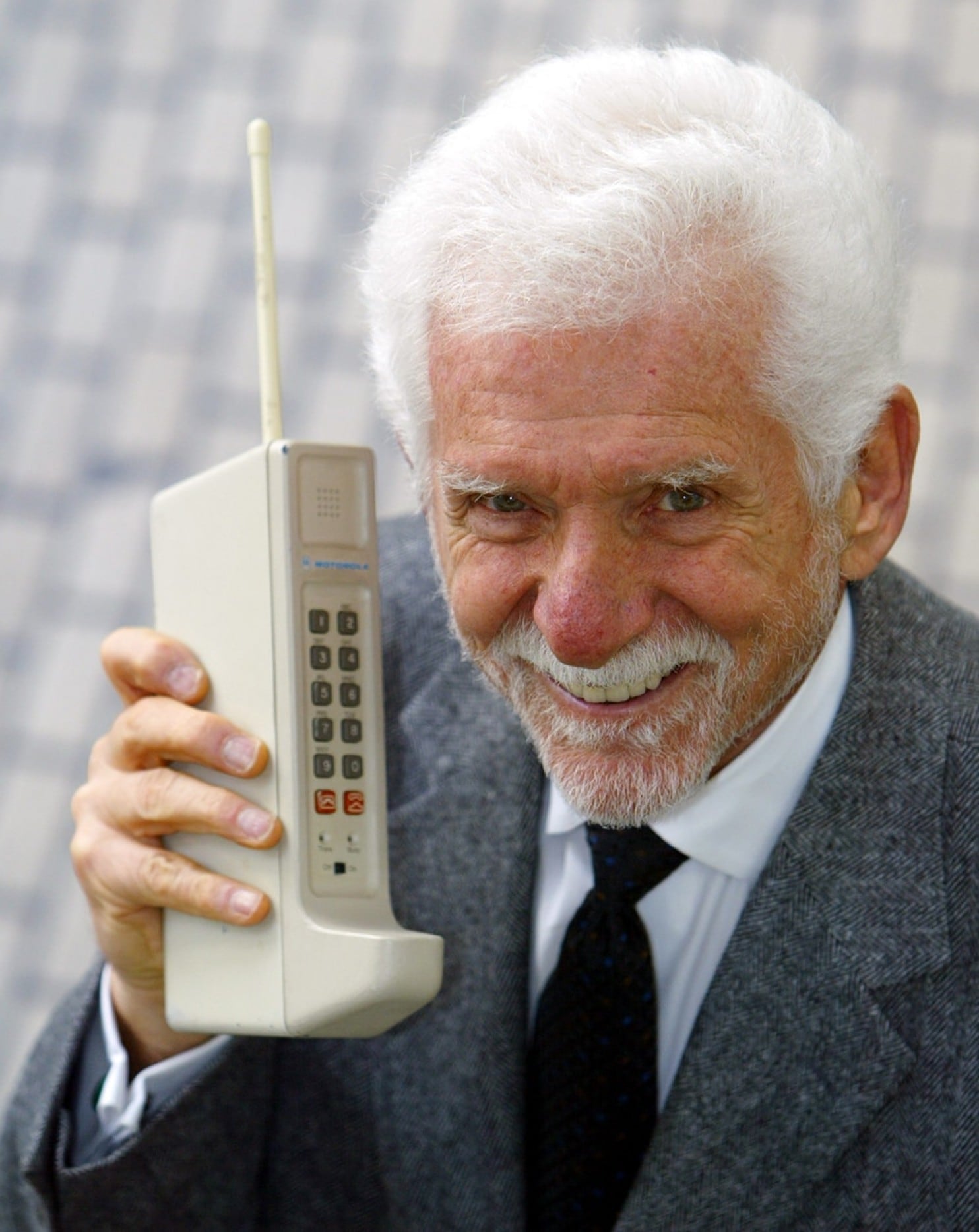 Martin Cooper, the head developer of the Motorola DynaTAC holding the phone. Image source
Martin Cooper, the head developer of the Motorola DynaTAC holding the phone. Image source
As technology advanced cell phones became smaller, equipped with extra features and were more accessible. Initially a cell phone could only perform the task of making phone calls, however, as technology progressed cell phones became gaming consoles, music players and in 1996 the first cell phone capable of internet access was launched my Nokia. This completely changed the way people communicate and eventually lead to the smart phone. Today smart phones have more computing power than the computers used for the Apollo missions in the 1960’s.
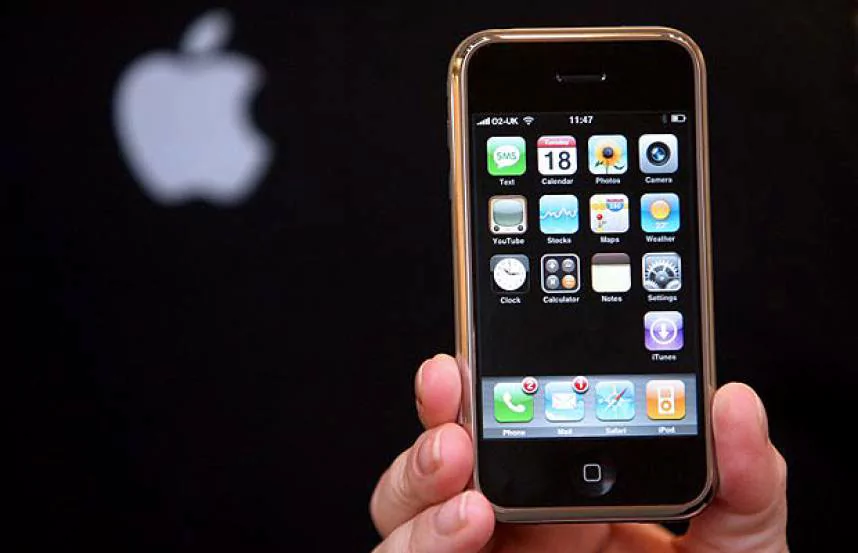 The launch of apples I Phone in 2007 is credited for propelling smartphones into the mainstream. Image source
The launch of apples I Phone in 2007 is credited for propelling smartphones into the mainstream. Image source
Through cell phone internet access, applications such as Mxit, BBM and WhatsApp were developed. Sending messages over these applications have become the preferred method of communication for many as they are cheaper than SMSing and making a phone call. The cell phone developed into a multimedia tool. It is now possible to communicate through images, sending pictures to show where we are, what we are eating or what is happening around us. The 9 to 5 workday has also been greatly affected, through cell phones people are always contactable and it has become easier and cheaper to share information through messaging and emails which means that work does not end for many when they get home. We use our cell phones more for surfing the web, checking emails, snapping photos, and updating our social media status than actually placing calls.
What’s next? The Future of the smartphone
The Computer
Early computers were very different from the computers used today, they were large, expensive and required a team of engineers to keep them functioning. While powered machines are synonymous with computers, interestingly, the first computer created was the abacus. Developed in ancient Babylon, China and Rome, the abacus is able to calculate, or ‘compute’ values. What could be seen as a closer relative of the modern computer, the mechanical calculator was first developed in France in 1642. It would take another 300 years for the birth of what is known as the ‘first generation’ of computers.
The evolution of the computer
The first automated digital computer was the Atanasoff-Berry Company (ABC), developed in 1939. Charles Babbage, and English mathematician and engineer, is credited for designing the first automatic computing engines and developing the principles that the modern computer based on. The Electronic Numerical integrator and Calculator (ENAIC) launched in 1946, and was the first general purpose electronic digital device. The ENAIC cost around $500 000 and was 4572 meters. In 1951 UNIVAC, the first commercially produced electronic digital computer was created. It weighed close to 8 tons and could compute 1000 calculations per second.
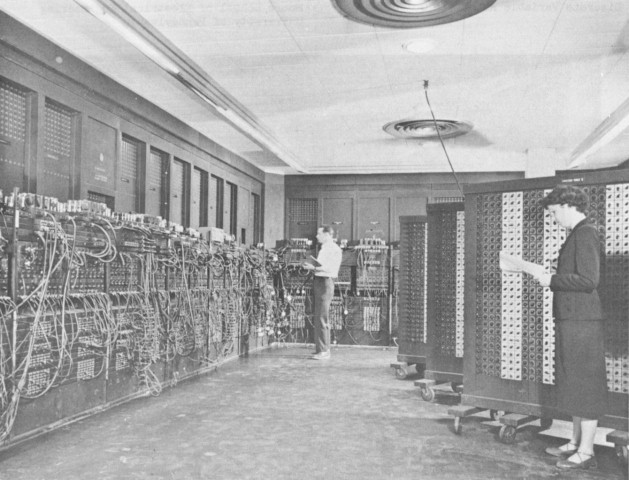 The ENAIC Image source
The ENAIC Image source
In the late 1950’s UNIVAC and other ‘first generation’ computers were replaced by ‘second generation’ computers. ‘Second generation’ computers were smaller and could perform more operations and used less power. The 1960’s and 1970’s saw ‘third generation’ computers, which possessed integrated circuits enter the market. Integrated circuits are silicon chips which contain multiple transistors.
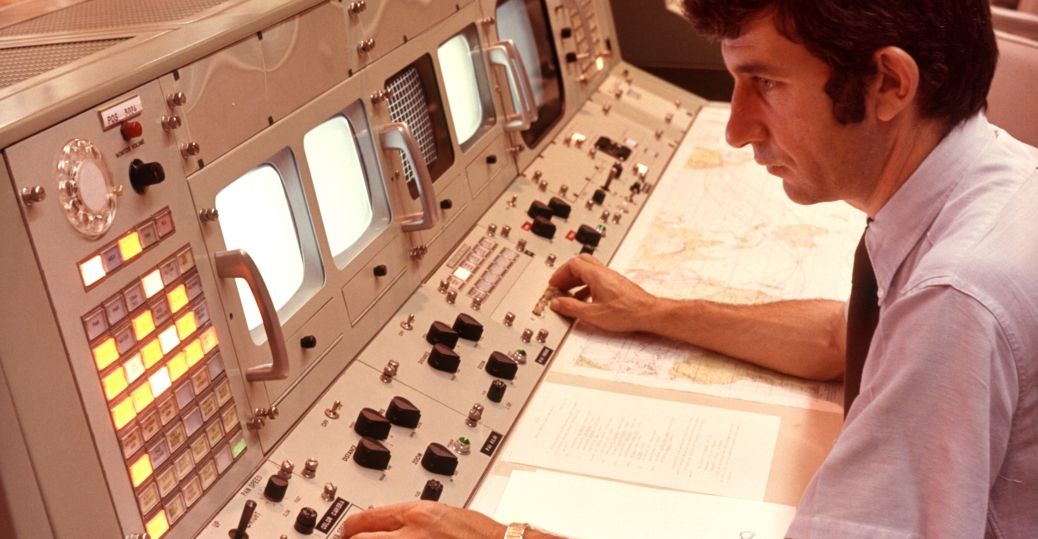 NASA Mission Control monitoring station in the 1970’s. Image source
NASA Mission Control monitoring station in the 1970’s. Image source
One of the most significant inventions that helped bring about the portable computer is the microprocessor. In 1971, Intel engineer Ted Hoff invented the microprocessor, a small silicon chip that contains the central processing unit (CPU). Prior to the invention of the microprocessor computers required a separate integrated circuit chip for each one of their functions. Microprocessors were the size of a thumbnail and had more functions and processing capabilities than integrated circuit chips. Computers became cheaper, smaller and easier to manufacture. The microprocessor paved the way for laptops and handheld computers like tablets.
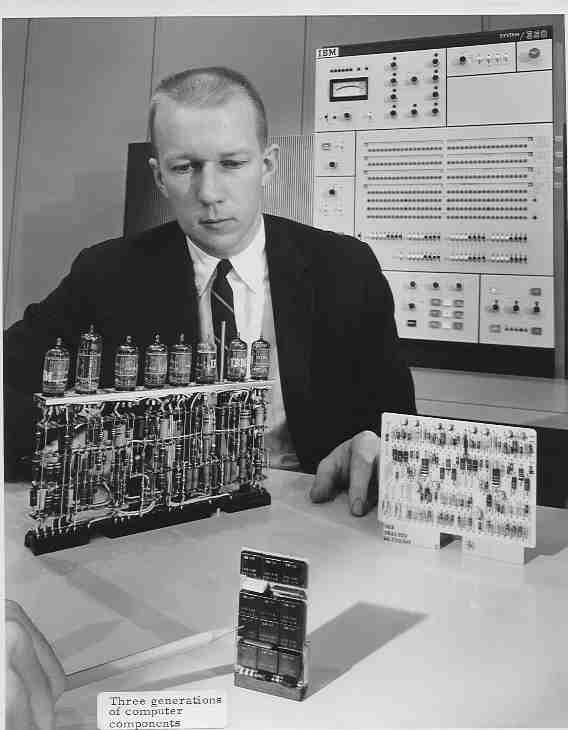 This image shows the technology used in the first generation of computers (the vacuum tubes, transistors and integrated circuits). Image source
This image shows the technology used in the first generation of computers (the vacuum tubes, transistors and integrated circuits). Image source
The first portable computers manufacture red such as the Altair 8800 were not very practical, they didn’t have a keyboard or a screen. Paul G Allen and Bill Gates were contracted to develop Altair’s programme language in order to make it more user friendly. With the money made Allen and Gates would go on to start Microsoft.
The apple computer, more sophisticated than the Altair was launched in 1976 by co-founders Steve Jobs and Stephen Wozaik. It came with memory and a monitor. The Apple II had a keyboard and a colour screen and was capable of storing data on an external device such as a cassette tape or a floppy disk.
This was the start of the pc revolution. Soon companies like Xerox and IBM entered the market and computers became synonymous with offices and were increasingly seen in homes seen in homes. Graphical User Interface (GUI) icons replaced complicated codes and, along with the introduction of the computer the PC mouse meant that more people were able to use the computer.
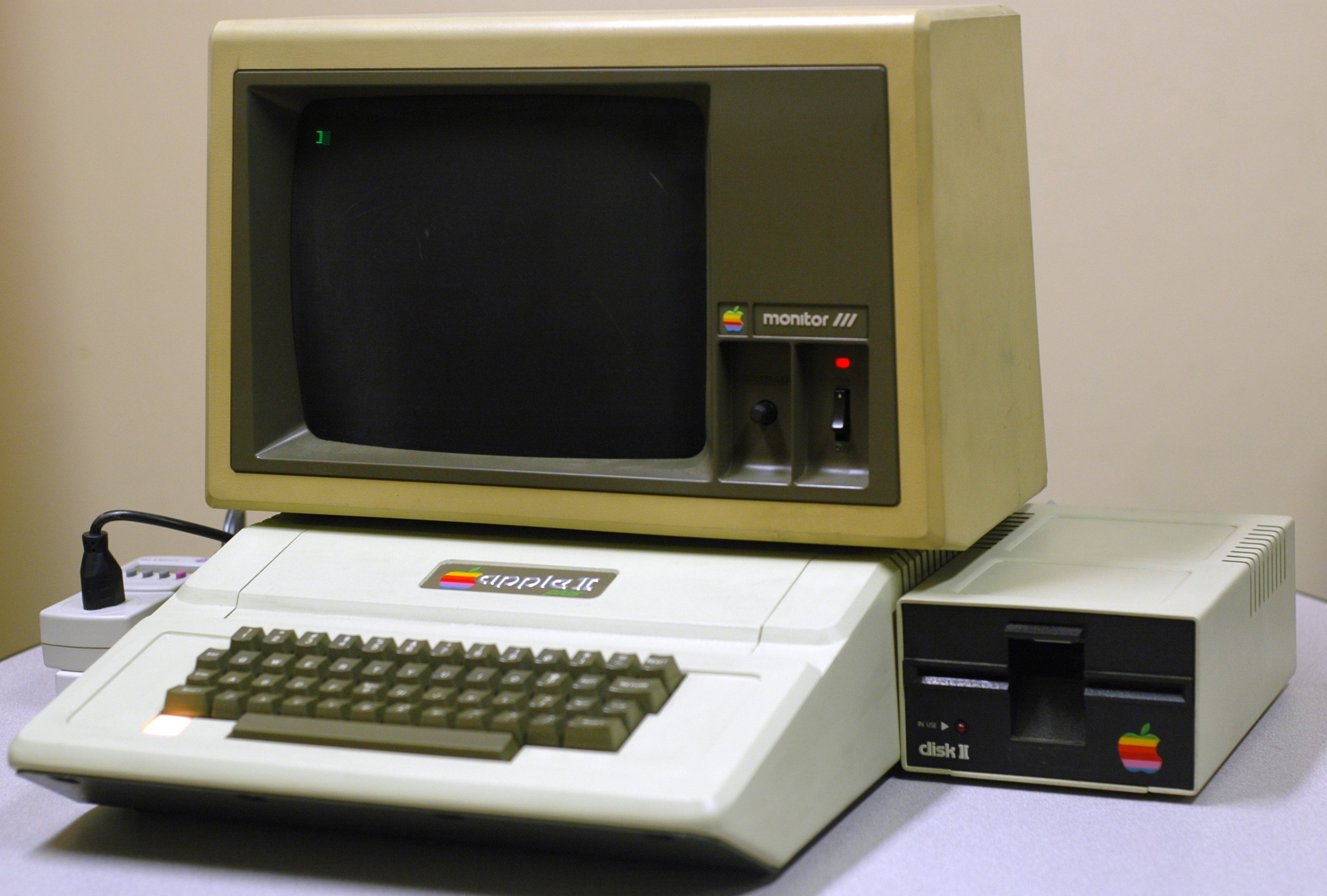 The Apple II. Image source
The Apple II. Image source
As technology has progressed, a fifth generation of computing has developed, artificial intelligence. Artificial intelligence hopes to make computers think like human beings and be able to make decisions without having to be programmed, thus to have new ideas and teach itself. Currently there are computers that can ‘learn’ how to play games by simply watching the screen, and seeing what causes the score to change or the hero in the game to die. Like human beings the computer has to think for itself and learn the rules of the game.
The future of computing: The Hololens
The internet
Today we make use of the internet for almost everything; we can access information in seconds, communicate with people around the world, play games, watch videos, shop and do our banking. It can be difficult to imagine a world without the internet and the World Wide Web, which began developing around 60 years ago. A single inventor cannot be attributed with the creation of the internet, instead, the internet came about through building on the communication technology that came before it. The Internet's history can be traced back to the Advanced Research Projects Agency Network (ARPANET), a United States military research network, which first went online in 1969.
During the Cold War, the Soviet Union launched the first unmanned satellite, Sputnik 1, into orbit. To ensure that the USA’s technology developed ahead of its enemies at the time, the Defence Advanced Research Project Agency (DARPA) was founded in 1958. DARPA created a large scale computer network in order to accelerate knowledge transfer; this would become known as the ARPANET. ARPANET used a method of data transmission called "packet switching" to link networks together for government and scientific use; information could be sent between universities with little time wasted on transferring knowledge. The first computer network was created in 1969; this would later lead to the development of the internet.
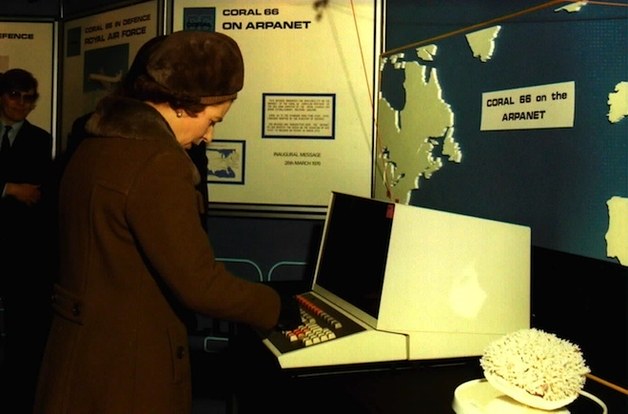 The Queen of England becoming the first head of state to send an email (26 March 1976). Image source
The Queen of England becoming the first head of state to send an email (26 March 1976). Image source
What's Difference between internet and the World Wide Web
Often when referring to the internet and the World Wide Web, it can be seen as referring to the same thing, however, they present two different components, one is the network and the other is the system which allows us to access the it.
The internet connects networks together, linking your computer to other computers around the world. The network enables computers to communicate with any other computer, as long as both are connected to the internet
The World Wide Web is the linked webpages accessed over the internet. Browsers such as Internet Explorer or Google Chrome are used to access webpages
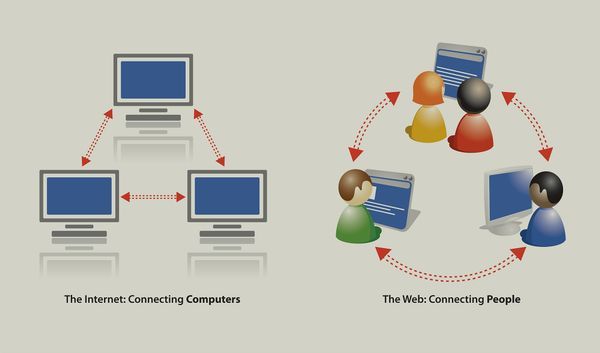 Difference Between the Internet and the Web. Image source
Difference Between the Internet and the Web. Image source
The Internet
The development of the internet cannot be attributed to one inventor. It was the advancement of knowledge across a number of countries and institutions which made the invention of the internet possible. Below are some of the most significant developments towards creation of the internet.
How the internet was invented
In the USA: In 1969 the United States Defence Department started a network called ARPANET. ARPANET was created to optimise file sharing through sharing power which meant computers could now process more than one task at time. Communication was done through linked packet networks, in which data is broken up into smaller blocks and transmitted via different channels and then put back together once it reaches its final destination.
On the 29th of October 1969, the first message was sent over ARPANET. The word ‘login’ was sent from the University of California to Stanford University, however, only two letters, ‘lo’ managed to send before the system crashed. After an hour the team responsible managed to send the entire word from one computer to another and from here on ARPANET grew and more institutions from London, Norway and Hawaii joined the network. As ARPANET developed, similar networks were developing in other places around the world.
The history of the internet
In Britain a commercial network was developed by the National Physical laboratory which came up with the idea of packet switching. Packet switching was a way of avoiding congestion at busy networks by cutting up data at one end and putting it back together at the other.
France developed a scientific research network called CYCLADES. They didn’t have much funding and thus decided to work on direct connections between computers instead of working with gateway computers. This made the host responsible for the delivery of data instead of the network itself. By the early 1970’s computer infrastructure had developed and communication was possible within networks, however but different networks such as CYCLADES and ARPANET could not communicate with each other.
The creation of Transmission Control Protocol (TCP)/Internet Protocol (IP) helped to solve this problem. TCP/IP was invented by computer scientist Vinton Cerf and forms the basic communication language of the internet. They label the packets of data and make sure that even though some pieces of the same data take different routes, they all end up at the proper destination and are put together once it reaches the intended user. Through the development of TCP/IP networks began communicating with one another in the mid 1970’s and the internet as we know it today was born.
The World Wide Web
The World Wide Web was transformed by Cerf’s TP/TCP. In the 1980’s researchers were able to send files and data from one PC to another. In 1991 the internet Timothy Berners Lee, a computer scientist working in Switzerland introduced the World Wide Web, a ‘web’ of information that could be access by anyone with an internet connection.
 Timothy Berners Lee. Image source
Timothy Berners Lee. Image source
Berners-Lee spent time with the European Organization for Nuclear Research (CERN) and wanted to create a way for scientists at CERN to easily share their information. He did this by creating an interface using HTTP, HTML, and URLs, which made internet browsing possible. He named his browser the World Wide Web and created the first website on 1 August 1991 at CERN.
The development of web browsers such as Mosaic in 1992 made the interface more user friendly. This meant that more and more people were able to navigate the internet and communicate online. Since then many other web browsers were created such as Mozilla Firefox, Internet Explorer and Google Chrome.
In 1971, Ray Tomlinson, a developer for ARPANET, started using the @ symbol to send messages from one computer to another. Although the actual inventor of the email is contested, this is seen as the birth of the modern e-mail. Today emails, or ‘electronic mail’ is used to send messages from one computer to another through making use of email addresses. Unlike posting mail, emails allow for instant communication to any part in the world. Images, voice recordings, videos and text can be communicated in a matter of seconds.
Video conferencing
Video conferencing allows for voice and video communication. It can be done over any device that has a webcam, such as a laptop or a smartphone. This makes it easy to see and communicate with people all over the world. It’s not necessary to travel in order to see friend or attend a meeting. One of the most popular applications for conducting video calls is Skype. Initially released in 2003, Skype enables video calls from any device such as a tables, computer or smartphone that is able to access the internet. As of 2015, Skype has over 300 million users’ world wide.
 Timothy Berners Lee. Image source
Timothy Berners Lee. Image source
Social networking communication
Social Media has completely changed the way we communicate. A phone call isn’t always used to get in touch with someone anymore; Facebook and Twitter are the main tools of communication. A status update is a way of finding out what our friends have been up to, or a way of communicating how we feel. . Facebook is the largest social media platform, having over 1.49 billion (2015) monthly active users. Social media allows us to keep in touch with friends and family all over the globe as well meet new people with similar interests.
How social media and the internet is affecting your life
The Evolution of communication
One of the first forms of communication was cave paintings, through which drawings communicated a story. After the invention of paper from papyrus letters became the preferred method of communication and post was sent all over the world. As technology developed communication could be done verbally over the telephone, radio and eventually over the cell phone. The internet and the World Wide Web completely changed the way we send and receive information. It became possible to send documents, pictures, or even video chat to anyone anywhere in the world. Communication has become cheaper and faster, while it may have taken a few weeks to send a letter to another country, now it’s possible to send it electronically as quick as a click of a button.




